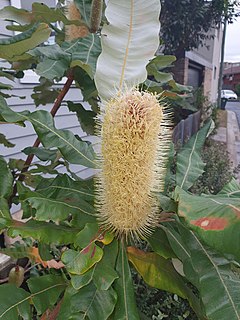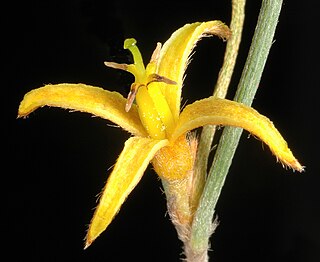
Banksia dentata, commonly known as the tropical banksia, is a species of tree in the genus Banksia. It occurs across northern Australia, southern New Guinea and the Aru Islands. Growing as a gnarled tree to 7 m (23 ft) high, it has large green leaves up to 22 cm (8.7 in) long with dentate (toothed) margins. The cylindrical yellow inflorescences, up to 13 cm (5.1 in) high, appear over the cooler months, attracting various species of honeyeaters, sunbirds, the sugar glider and a variety of insects. Flowers fall off the ageing spikes, which swell and develop follicles containing up to two viable seeds each.
Allosyncarpia ternata, commonly known as an-binik, is a species of rainforest trees constituting part of the botanical family Myrtaceae and included in the eucalypts group. The only species in its genus, it was described in 1981 by Stanley Blake of the Queensland Herbarium. They grow naturally into large, spreading, shady trees, and are endemic to the Northern Territory of Australia. They grow in sandstone gorges along creeks emerging from the Arnhem Land plateau.

Banksia proteoides, commonly known as king dryandra, is a shrub endemic to Western Australia. It was known as Dryandra proteoides until 2007, when all Dryandra species were transferred to Banksia by Austin Mast and Kevin Thiele.

Grevillea pteridifolia is a species of Grevillea native to Australia. Common names include silky grevillea, Darwin silky oak, ferny-leaved silky oak, fern-leaved grevillea, golden grevillea, golden tree and golden parrot tree. It occurs in Western Australia, Northern Territory, and Queensland.

Grevillea heliosperma, commonly known as rock grevillea, is a shrub native to northern Australia, generally growing around 3 to 5 m tall, rarely to 8 m (26 ft). It has red flowers.

Adenanthos barbiger, the hairy jugflower or hairy glandflower, is a species of shrub in the family Proteaceae. It is endemic to the south-west of Western Australia. It usually grows to 1 metre high, and has bright red flowers that appear mostly between August and December. The species was first formally described in 1839 by English botanist John Lindley in A sketch of the vegetation of the Swan River colony.

Persoonia levis, commonly known as the broad-leaved geebung, is a shrub native to New South Wales and Victoria in eastern Australia. It reaches 5 m (16 ft) in height and has dark grey papery bark and bright green asymmetrical sickle-shaped leaves up to 14 cm (5.5 in) long and 8 cm (3.2 in) wide. The small yellow flowers appear in summer and autumn, followed by small green fleshy fruit, which are classified as drupes. Within the genus Persoonia, it is a member of the Lanceolata group of 58 closely related species. P. levis interbreeds with several other species where they grow together.

Persoonia linearis, commonly known as the narrow-leaved geebung, is a shrub native to New South Wales and Victoria in eastern Australia. It reaches 3 m (9.8 ft), or occasionally 5 m (16 ft), in height and has thick, dark grey papery bark. The leaves are, as the species name suggests, more or less linear in shape, and are up to 9 cm (3.5 in) long, and 0.1 to 0.7 cm wide. The small yellow flowers appear in summer, autumn and early winter, followed by small green fleshy fruit known as drupes. Within the genus Persoonia, it is a member of the Lanceolata group of 58 closely related species. P. linearis interbreeds with several other species where they grow together.

Persoonia lanceolata, commonly known as lance-leaf geebung, is a shrub native to New South Wales in eastern Australia. It reaches 3 m (10 ft) in height and has smooth grey bark and bright green foliage. Its small yellow flowers grow on racemes and appear in the austral summer and autumn, followed by green fleshy fruits which ripen the following spring. Within the genus Persoonia, P. lanceolata belongs to the lanceolata group of 58 closely related species. It interbreeds with several other species found in its range.

Persoonia confertiflora, commonly known as cluster-flower geebung, is a species of flowering plant in the family Proteaceae and is endemic to south-eastern Australia. It is an erect to low-lying shrub with hairy young branches, egg-shaped to narrow elliptic leaves, and hairy yellow flowers borne on leaf axils or on the ends of short branches.

Persoonia laurina, commonly known as the laurel-leaved or laurel geebung, is a shrub of the family Proteaceae native to central New South Wales in eastern Australia. Found in sclerophyll forest, it grows to a height of 2 metres. The yellow flowers appear in late spring.

Persoonia chamaepitys, commonly known as the prostrate- or mountain geebung, is a shrub endemic to New South Wales in eastern Australia. It has a prostrate habit, reaching only 20 cm (7.9 in) high but spreading up to 2 m (6.6 ft) across, with bright green spine-like leaves and small yellow flowers appearing in summer and autumn.

Sersalisia sericea, also known as wild prune, mangarr, and mongo is a species of shrubs or small trees, of the plant family Sapotaceae They grow naturally in monsoon forest, littoral rainforest and occasionally in more open forest types across Northern Australia.

Lysiphyllum cunninghamii is a species of plant in the family Fabaceae. It is native to northern Australia where it occurs from Western Australia through the Northern Territory to Queensland.

Melaleuca argentea, commonly known as the silver cadjeput, silver-leaved paperbark, silver cajuput, or mardderr in the Kunwinjku language, is a plant in the myrtle family, Myrtaceae and is endemic to northern Australia. It is a common tree along river banks or around swamps in the tropics. It has papery bark and weeping foliage and has been the subject of important scientific research.

Persoonia brevifolia is a plant in the family Proteaceae and is endemic to a restricted area near the border between south-eastern New South Wales and Victoria. It is an erect shrub with elliptic to egg-shaped leaves and cylindrical yellow flowers arranged singly in leaf axils.

Persoonia angustiflora is a species of flowering plant in the family Proteaceae and is endemic to the south-west of Western Australia. It is an erect shrub with hairy branches and leaves, linear, more or less cylindrical leaves and yellow or greenish yellow flowers arranged singly or in groups of up to four.
Calytrix achaeta, commonly known as the white-flowered turkey bush, kerosene wood or fringe-myrtle, is a species of plant in the myrtle family Myrtaceae that is native to Western Australia and the Northern Territory.

Petrophile semifurcata is a species of flowering plant in the family Proteaceae and is endemic to an area near the west coast of Western Australia. It is an erect, bushy shrub with sharply-pointed, needle-shaped, sometimes lobed leaves and oval heads of silky-hairy, whitish, lemon-yellow or cream-coloured flowers.
Terminalia grandiflora, commonly known as yalu, plumwood or nutwood, is a tree of the family Combretaceae native to northern Australia. The Nungali and Jaru peoples know the tree as badgari and the Wagiman know it as barnyin.


















